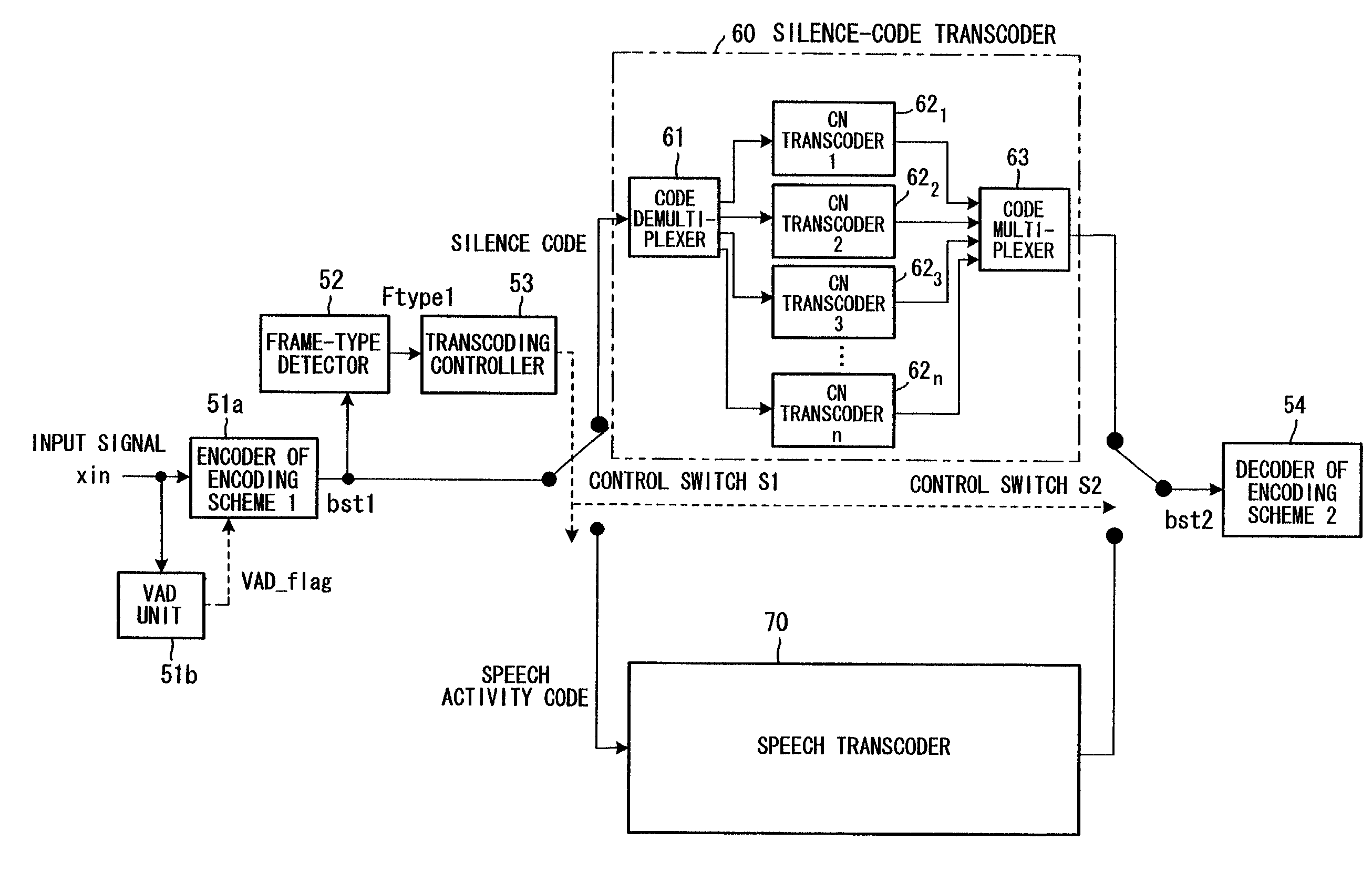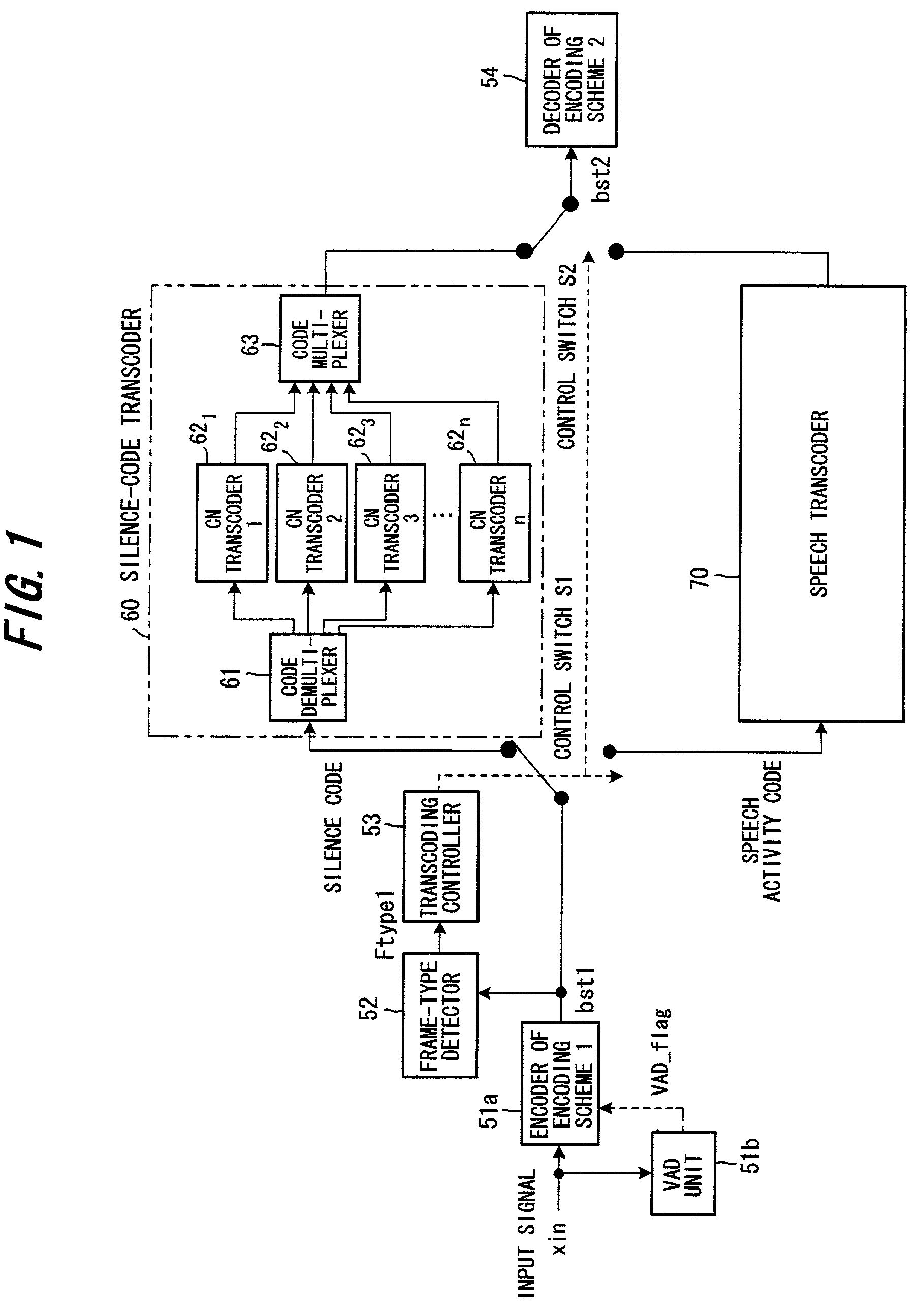Speech transcoding method and apparatus for silence compression
a speech and code technology, applied in the field of speech transcoding methods and apparatuses, can solve the problems of increased delay, marked decline in speech decoding quality, and inability to make speech transcoding,
- Summary
- Abstract
- Description
- Claims
- Application Information
AI Technical Summary
Benefits of technology
Problems solved by technology
Method used
Image
Examples
first embodiment
[0090](B) First Embodiment
[0091]FIG. 2 is a block diagram of a first embodiment of silence-transcoding according to the present invention. This illustrates an example in which AMR is used as encoding scheme 1 and G.729A as encoding scheme 2. In FIG. 2, an nth frame of channel data bst1(n), i.e., channel data, enters a terminal 1 from an AMR encoder (not shown). The frame-type detector 52 extracts frame-type information Ftype1(n) contained in the channel data bst1(n) and outputs this information to the transcoding controller 53. Frame-type information Ftype(n) in the AMR scheme is of four kinds, namely speech activity frame (SPEECH), SID frame (SID_FIRST), SID frame (SID_UPDATE) and non-transmit frame (NO_DATA) (see FIGS. 24 and 25). The silence-code transcoder 60 exercises CN-transcoding control in accordance with the frame-type information Ftype1(n).
[0092]In CN-transcoding control, it is necessary to take into consideration the difference in frame lengths between AMR and G.729A. As...
second embodiment
[0123](C) Second Embodiment
[0124]FIG. 6 is a block diagram of a second embodiment of the present invention, in which components identical with those of the first embodiment shown in FIG. 2 are designated by like reference characters. As in the first embodiment, the second embodiment adopts AMR as encoding scheme 1 and G.729A as encoding scheme 2. In this instance, conversion processing for a case where the frame type Ftype1(n) of the AMR scheme detected by the frame-type detector 52 is SID_FIRST is executed.
[0125]In this case also where one frame in the AMR scheme is an SID_FIRST frame, conversion processing is executed upon setting the mth frame and (m+1)th frame of the G.729A scheme as an SID frame and non-transmit frame respectively, as shown in (b-2) of FIG. 4B, in a manner similar to the case where the AMR frame is an SID_UPDATE frame [(b-1) in FIG. 4B] in the first embodiment. However, in the case of an SID_FIRST frame in the AMR scheme, it is necessary to take into account th...
third embodiment
[0134](C) Third Embodiment
[0135]FIG. 7 is a block diagram of a third embodiment of the present invention, in which components identical with those of the first embodiment are designated by like reference characters. The third embodiment illustrates an example in which G.729A is used as encoding scheme 1 and AMR as encoding scheme 2. In FIG. 7, an mth frame of channel data, bst1(m) i.e., speech code, enters terminal 1 from a G.729A encoder (not shown). The frame-type detector 52 extracts frame-type information Ftype(m) contained in bst1(m) and outputs this information to the transcoding controller 53. Frame-type information Ftype(m) in the G.729A scheme is of three kinds, namely speech activity frame (SPEECH), SID frame (SID) and non-transmit frame (NO_DATA) (see FIG. 23). The transcoding controller 53 changes over the switches S1, S2 upon identifying speech activity segments and silence segments based upon frame type.
[0136]The silence-code transcoder 60 executes CN-transcoding proce...
PUM
 Login to View More
Login to View More Abstract
Description
Claims
Application Information
 Login to View More
Login to View More - R&D
- Intellectual Property
- Life Sciences
- Materials
- Tech Scout
- Unparalleled Data Quality
- Higher Quality Content
- 60% Fewer Hallucinations
Browse by: Latest US Patents, China's latest patents, Technical Efficacy Thesaurus, Application Domain, Technology Topic, Popular Technical Reports.
© 2025 PatSnap. All rights reserved.Legal|Privacy policy|Modern Slavery Act Transparency Statement|Sitemap|About US| Contact US: help@patsnap.com



